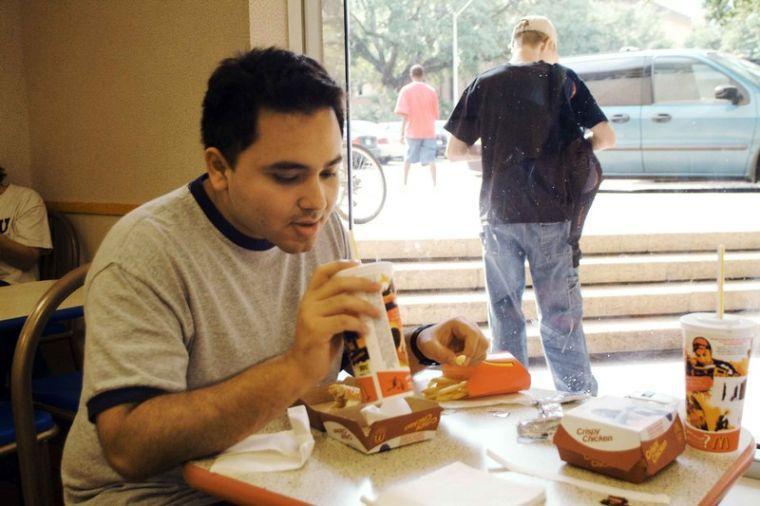Lori Byargeon, a French junior, said when she studied abroad inFrance this summer, she was surprised when, at a dinner with herhost family in the French countryside, her hosts’ friends asked herwhy she and another American student were not fat like otherAmericans.
“It was weird to ask us that when we were sitting down to asix-course meal,” Byargeon said. “Since they weren’t in Paris, itseemed to be more of the stereotype we know.”
Cuisine changes across the globe, but American-based fast foodchains and portion sizes are some factors that contribute to theAmerican overeating stereotype.
Erick Soto, a chemistry graduate student from Mexico, said theconvenience of fast food has caused his diet to changedrastically.
“My diet has changed for the worse [since moving to the U.S.],”Soto said.
Soto said he eats fast food one to two times each week, but heused to eat fast food only two times a month before moving toAmerica two and a half years ago. Soto said he ate home-cookedmeals before coming to America.
Rishipal Bansode, a food science doctoral student from India,was eating at the McDonald’s in the Union when interviewed.
“I cook my own meals most of the time,” Bansode said. He said hecooks traditional ethnic foods.
Bansode said he was eating in McDonald’s because he had apresentation due Tuesday and did not have time to go home and cooka meal.
Bansode said that in his home country, eating fast food used tobe considered taboo, but not anymore in metropolitan areas likeHyderabad, a large city.
Naveen Pallempati, an industrial engineering graduate studentfrom India, also said he sticks to traditional Indian food.
“There is a large Indian community here, and lots of Indianrestaurants here,” Pallempati said.
Pallempati said he likes beef and barbecue, but it is veryexpensive to eat in nice restaurants in America, so he sometimeseats fast food.
Abed Mubarak, owner and manager of Atcha Bakery and Cafe, saidhis restaurant serves Greek and Lebanese dishes and import spicesand groceries that also are sold in the restaurant. Mubarak said heserves traditional ethnic food, and many international studentscome to his restaurant.
Mubarak, who is from Jerusalem, said size portions may notmatter as much as the nutritional value of the food.
“People back home eat big portions, too,” Mubarak said. “Foodback home may be more healthy and not have as much fat.”
University dining also includes international cuisine in mealplans.
Ron Steelman, director of LSU Dining, prepares menus forHighland and Pentagon Dining Halls, and said it is a challenge totry to develop menus that serve a wide variety of tastes.
“We will look at our menus every semester in Highland andPentagon,” Steelman said. “If we hear from students, we’llincorporate their input into the menu. We’re always trying newthings.”
Steelman said Italian food, such as pasta, is the most popularmeal.
Italian cuisine is most visible on the menu, a pasta optionavailable every day.
Steelman also said other international cuisine, such as Chinese,Indian items with recipes that include the Indian spice curry,Cuban-style jerk chicken and pork items are on the menus at theall-you-can-eat program in resident dining.
Steelman said currently plates in the dining areas measure nineinches, but the dining areas will be renovated to have morecook-to-order stations, so plate sizes possibly could change aswell.
David Pratka, director of retail operations for LSU dining, saidthe Union already offers cook-to-order stations, such as Minh’s, aChinese restaurant that “allows you to put your own mealtogether.”
“We do a four-ounce portion of meat, which is standard for ameal,” Pratka said. “It is more health conscious in the long run tohave a set meal. You have an allotment of proteins, and you can’tgorge yourself.”
Baton Rouge offers fast food, international cuisine
October 26, 2004
Baton Rouge offers fast food, international cuisine






